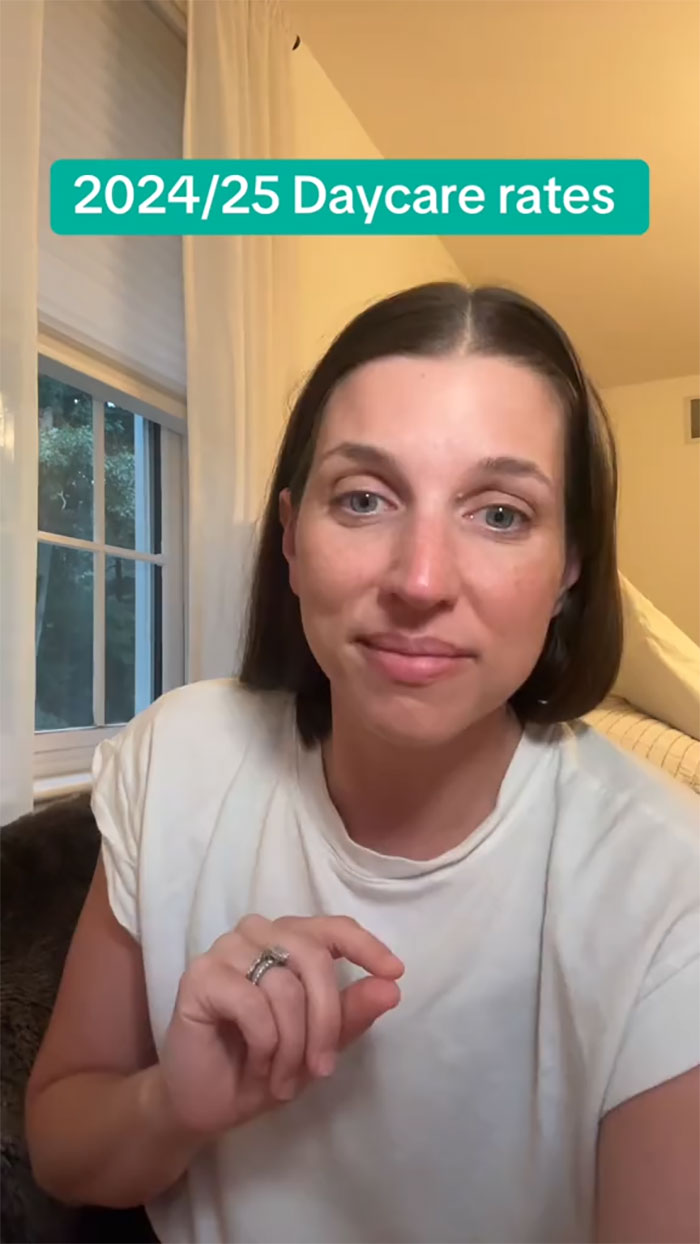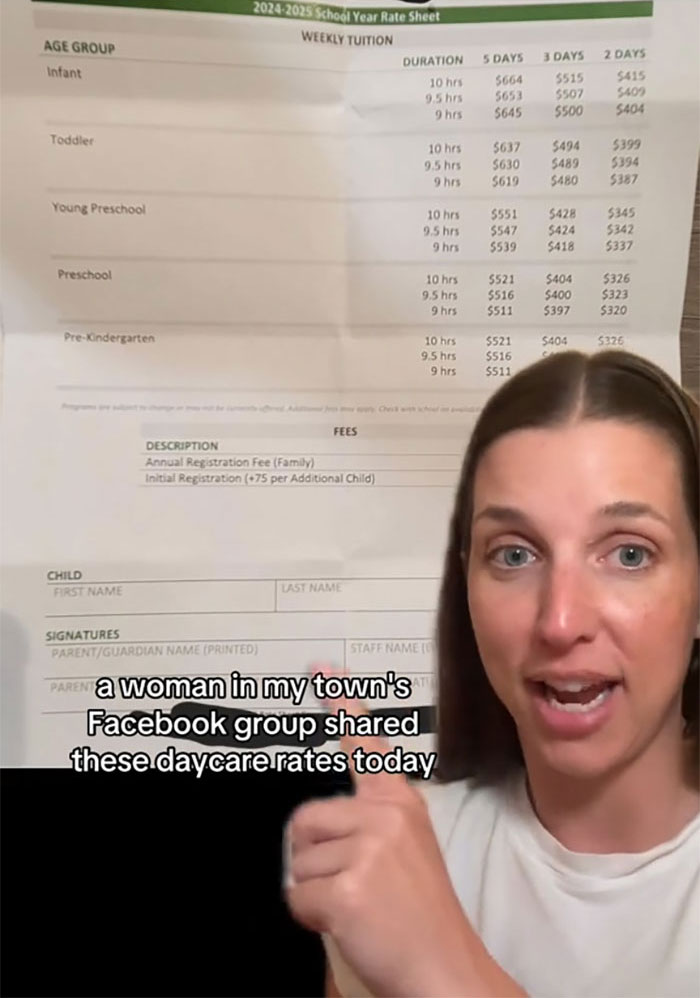It’s no secret that having children can be mind-bogglingly expensive. When you start looking at the total costs that you’re likely to pay as a parent, you’ll be forgiven if your jaw drops. According to recent research, it would take parents over $310k to raise a child until the age of 17.
Working mother-of-four Paige Connell (@sheisapaigeturner) is well-known online for sharing childcare, marriage, and motherhood advice. She went viral after filming a video in which she explained that one of the major reasons why people in the United States are having fewer children may be linked to the massive costs of childcare and daycare. Scroll down to learn more. Bored Panda reached out to Connell, and she was kind enough to share her thoughts on childcare, as well as why it’s a systemic issue instead of just a personal burden. You’ll find our full interview with her as you read on.
More info: TikTok | Instagram | Facebook | YouTube | Spotify | Website
Paige Connell went viral after explaining in a video clip just how expensive childcare and daycare can be in the United States

According to her, it’s these costs that are making some adults consider having no kids or fewer kids








Image credits: Tatiana Syrikova/Pexels (not the actual photo)





Image credits: Kaboompics.com/Pexels (not the actual photo)



You can watch the mom’s full viral video right over here
@sheisapaigeturner People are choosing to have no kids or fewer kids because they simply cannot afford them. The cost of childcare has gone up exponentially over the last 10 to 20 years. On average in the state of Massachusetts it’s about $20,000 a year per child. These rates are unsustainable for most families, which is why more and more people choosing not to have children. Affordable childcare would not only benefit families and children, but it would benefit our economy and society as a whole #childcare#daycare#daycarelife#childcarecrisis#millennialmom#momsoftiktok#newparents#workingmom
“The U.S. has some of the highest childcare costs in the world, yet many families struggle simply because affordable options are scarce”
We asked Connell what could realistically be done to improve the childcare and daycare situation in the United States. “The U.S. needs to invest in childcare as a fundamental part of our social infrastructure. Other developed countries provide public funding and subsidies to make childcare more accessible, and the U.S. should follow suit,” she told Bored Panda via email.
“Affordable childcare isn’t just beneficial for parents—it strengthens the economy by keeping more parents, especially women, in the workforce. Solutions could include increased public funding, expanded subsidies for families, tax credits for childcare expenses, and better wages for childcare providers to ensure quality care while reducing costs for parents. Childcare isn’t a private problem for families to figure out alone; it’s a systemic issue that requires policy solutions at the national level.”
Connell highlighted the fact that new parents should know that childcare costs aren’t just a personal burden but a systemic issue “rooted in the lack of government support and public investment.”
“The U.S. has some of the highest childcare costs in the world, yet many families struggle simply because affordable options are scarce. To navigate this, parents should research available care options, including state-funded pre-K, childcare subsidies, employer-sponsored benefits, and tax credits like the Child and Dependent Care Credit,” she advised, offering some practical advice to new parents who might feel financially overwhelmed.
“It’s also crucial to understand that childcare costs don’t disappear when kids start school—before-school care, after-school programs, and summer camps can add up quickly. By being aware of these ongoing expenses and the broader systemic challenges, parents can make more informed financial and career decisions while also pushing for policies that make childcare more accessible and affordable for everyone.”
Connell also opened up about how she first began sharing her thoughts on social media. “I started sharing my experiences because childcare costs are often treated as personal or ‘women’s issues’ when, in reality, they are systemic problems that impact families, workplaces, and the economy as a whole. For too long, families have been left to figure out childcare on their own, and the financial burden disproportionately falls on women, forcing many out of the workforce,” she told Bored Panda.
“By being transparent about the real cost of childcare—whether it’s daycare, summer camps, or after-school programs—I hope to shift the conversation away from individual family choices and toward the need for policy changes and systemic solutions. The more awareness we bring to these challenges, the harder they are to ignore, and that awareness is what ultimately drives change. Families deserve support, and it starts with recognizing that childcare isn’t just a private expense—it’s a societal issue that affects all of us.”
It can cost nearly a third of a million dollars for American families to raise a child until they’re 17 years old
As per the Centers for Disease Control and Prevention, nearly 3.7 million babies were born in the United States in 2022. That year, the country had a birth rate of 11 per 1k people and a fertility rate of 56 births per 1k women aged 15 to 44 years old. Nearly a third (32.1%) of all births in the US that year were cesareans.
Investopedia reports that the average middle-income family with two children will spend around $310,605 to raise a child who was born in 2015 all the way until 2032, when they reach the age of 17. This is a massive spike from 2015, when that same average cost stood at ‘just’ $233,610.
Housing (including mortgage or rent payments, taxes, insurance, repairs, utilities, maintenance, and household goods) makes up a whopping 32% of these expenses. The average American household spent $25,436 on housing per year in 2023. Meanwhile, the median household income in the US, as per the US Census Bureau, was $80,610 that year.
Food costs can eat up (pun not intended) between 15% to 24% of the family’s income. A lot depends on the quality and quantity of the food that you buy, where you live, what your diet is like, how often you go out to eat versus cooking at home, and other factors.
Meanwhile, childcare can cost between 7% to 23% of the family’s income. There’s lots of variability here because different families have different circumstances. How much you pay for daycare, for instance, will depend on whether both parents are working, whether any relatives live nearby to help with the babysitting, the number of children you have, where you live, etc.
“In 2022, costs ranged from $5,357 for school-age home-based care in small counties to $17,171 for infant center-based care in large counties,” Investopedia notes.
The shocker is that the $310k+ cost to raise a child does not include the costs of getting higher education in college. Again, the costs can vary quite a bit depending on the type of school (public versus private), the length of the program (two versus four years), and the specific institution itself.
Generally speaking, the average annual cost for the 2024-2025 academic year for a public in-state college was $24,920 (including tuition, fees, and room and board). Compare that to the average $58,600 you’re likely to spend per year for a private college.
Aside from this, you’ll also have to factor in other costs like clothing, insurance, transportation, healthcare, sports, vacations, family trips hobbies, and extracurricular activities. To reiterate: raising your children and taking care of their higher education is incredibly expensive in the US.
Childcare in the US is among the most expensive in the entire world. On the flip side, some developed nations have made daycare very affordable
CNN reported that placing two kids at a childcare center in 2023 costs at least 25% more than the typical average rent in every state in the US. Moreover, you could expect to pay at least twice as much as the average rent in 11 states and the District of Columbia.
In 2023, the average annual cost of care rose by 3.7% compared to 2022, reaching a jaw-dropping $11,582 per child.
Referring to data from the Bureau of Labor Statistics, the Pew Research Center notes that the price of daycare and preschool rose around 22% between January 2020 and September 2024.
In one 2022 survey, a fifth of parents who needed childcare reported that there were times in the past year when they didn’t have enough money to pay for those services.
The World Economic Forum reports that childcare costs account for 32% of the income of an average American couple. This number stands at 30% in New Zealand, 29% in Cyprus, and 28% in Czechia. It’s around a quarter of the average couple’s income in the United Kingdom.
On the flip side, couples barely have to spend anything in Germany (1%) and Estonia (0%). In Germany, the average annual cost of childcare comes out to $1,425 per year or just under $118 per month, according to the WEF. And in Estonia, children are entitled to highly subsidized kindergarten places from 18 months old until they are 7 years old. That means that full-time childcare will set families back as little as $19 per week!
Connell covers relatable topics like motherhood, marriage, and childcare in short videos and online posts. She has a large following on social media, including 216k followers on Instagram, 69k fans on Facebook, and over 258k people following her on TikTok.
What’s more, the mom-of-four is one of the hosts of the Do You Want The Truth? Podcast on Spotify and is one of the co-founders of the On the Same Page show on YouTube.
Her video was watched 360k times at the time of writing and also garnered 22.6k likes and nearly 2k comments.
What has your relationship with childcare and daycare costs been like, dear Pandas? What country do you live in, and how much do you pay for these services? Have you ever felt like you can’t start a family because of how expensive childcare can be? Let us know in the comments below.
Here’s how some of Connell’s followers reacted after they saw the clip






























The post Mom Shares Why Young People Are Not Having Kids: “They Simply Cannot Afford It” first appeared on Bored Panda.
from Bored Panda https://ift.tt/I6pO8sJ
via IFTTT source site : boredpanda